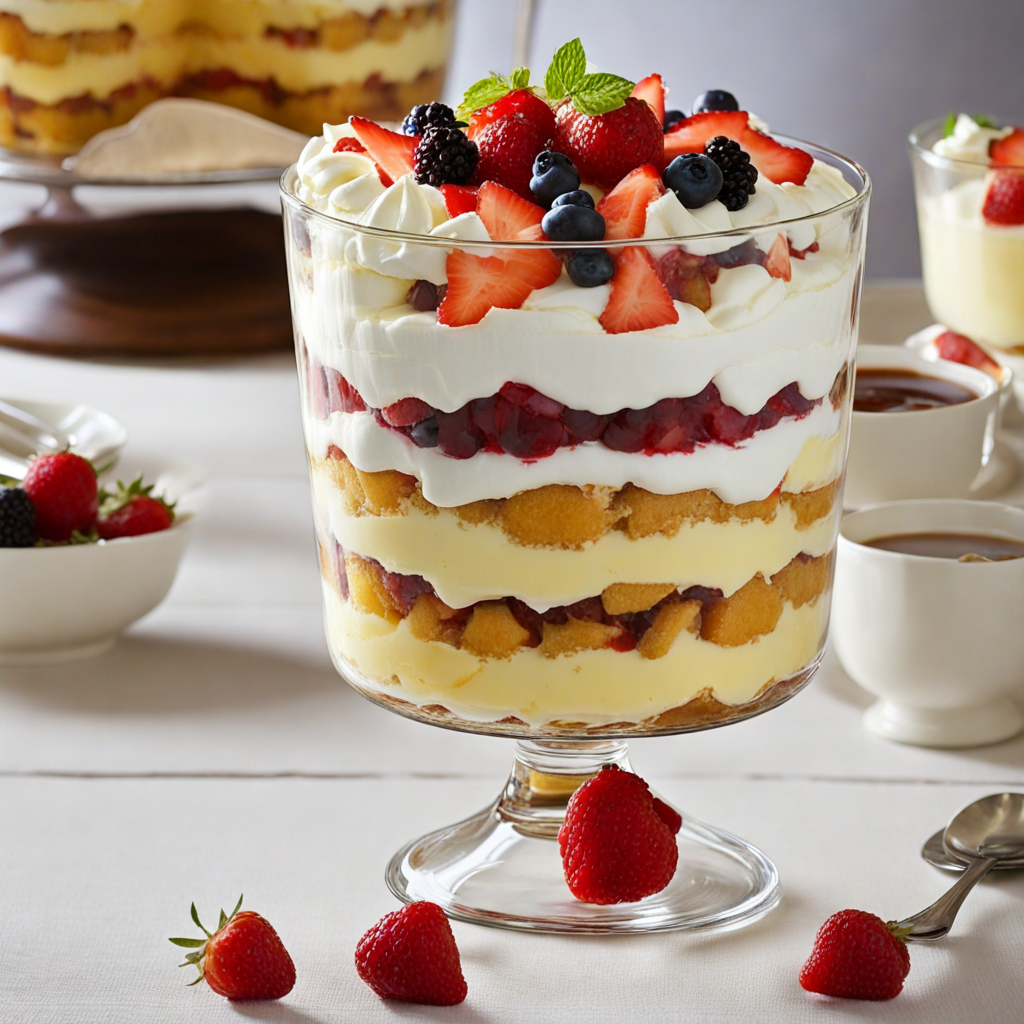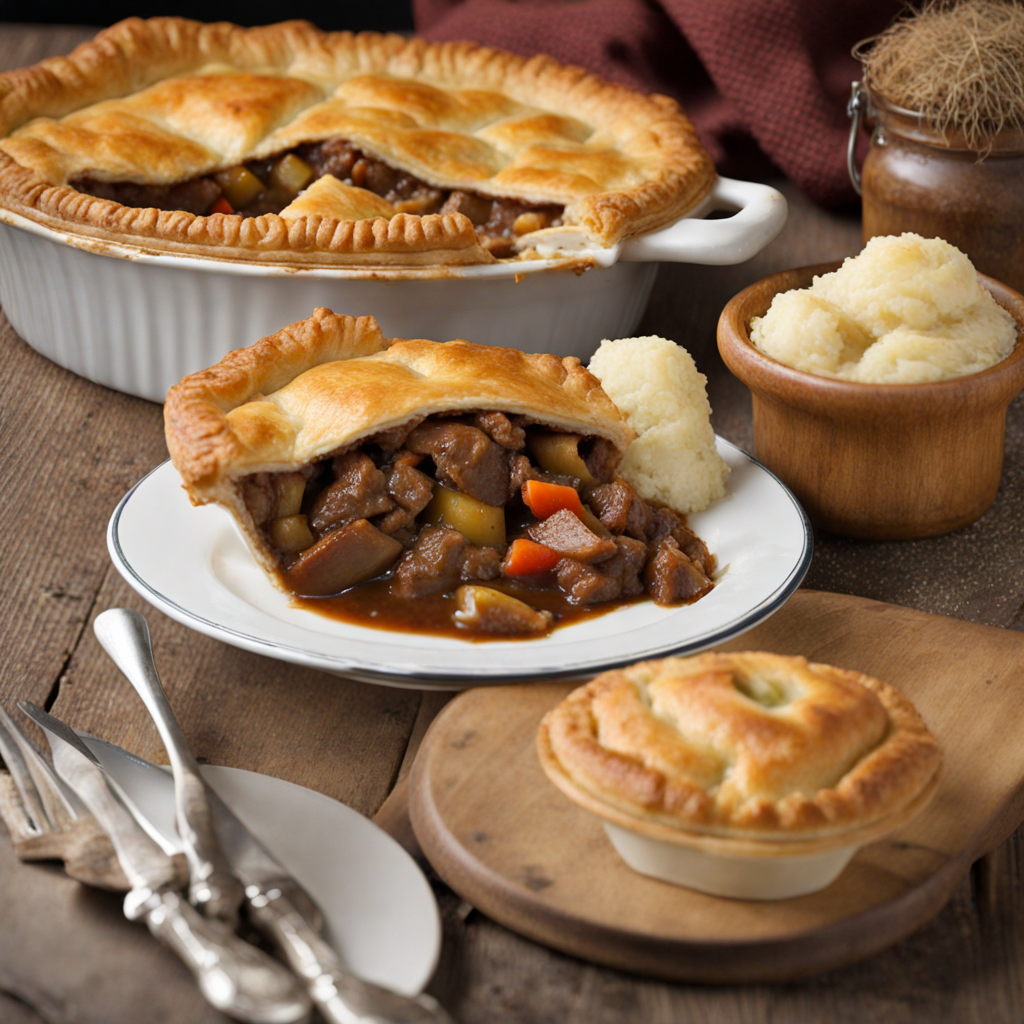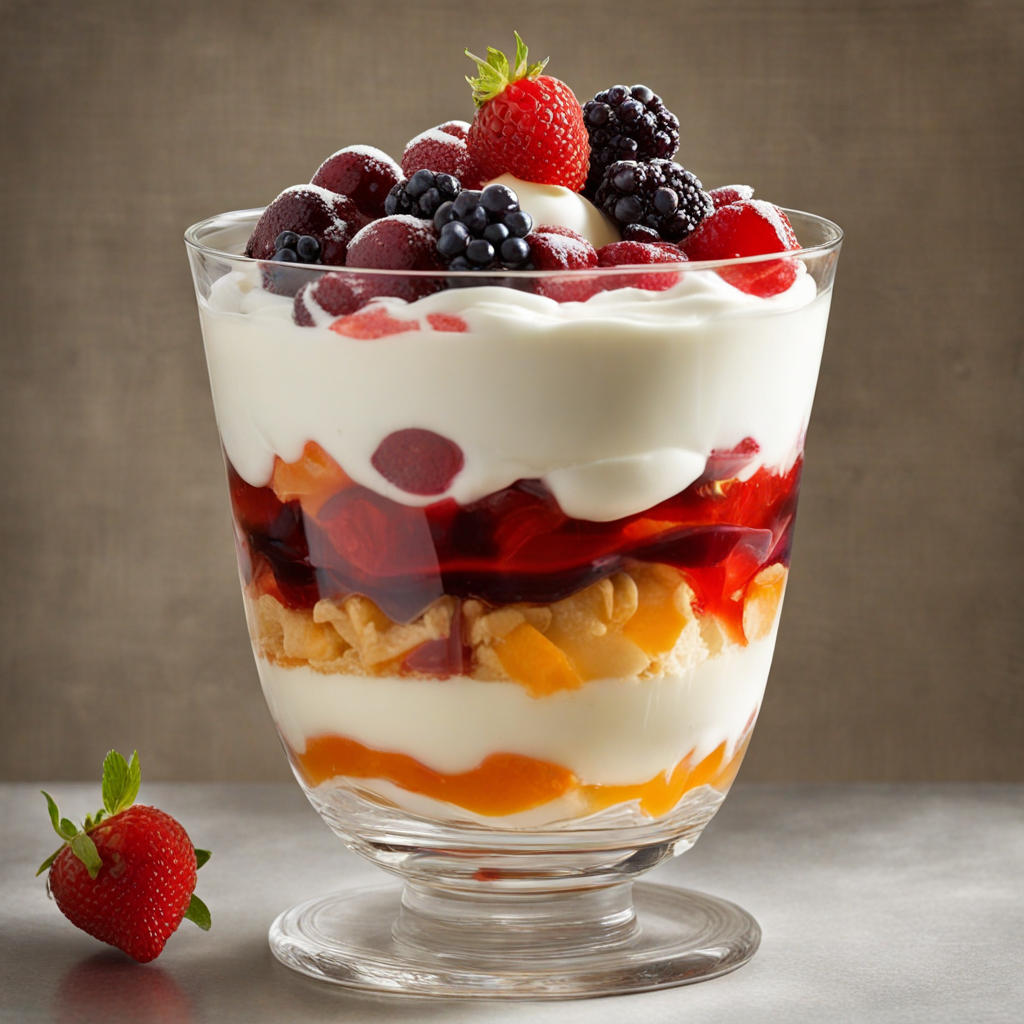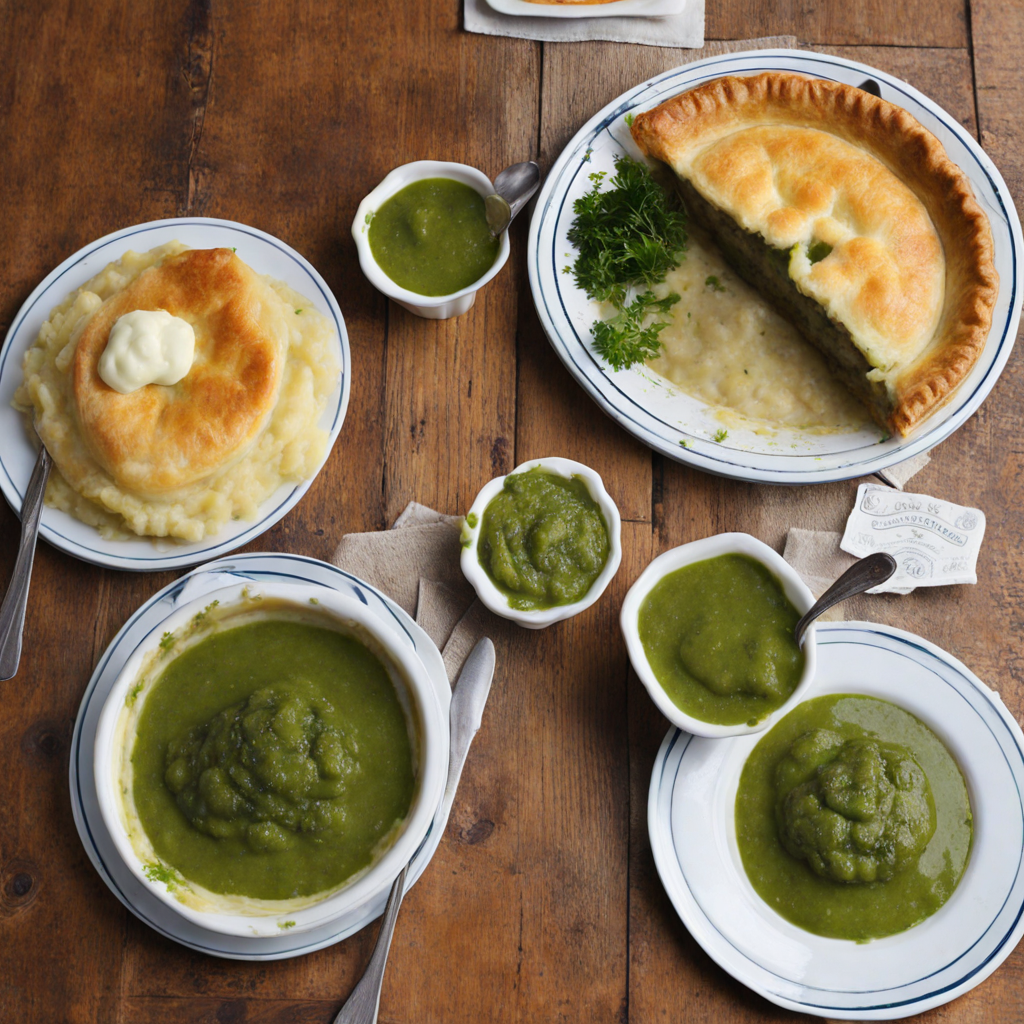Trifle
Trifle is a quintessential British dessert that beautifully layers a delightful combination of flavors and textures, making it a feast for both the eyes and the palate. Traditionally, it starts with a base of sponge cake, often soaked in sherry or fruit juice, which provides a moist and flavorful foundation. The cake is then generously topped with a vibrant fruit layer, commonly featuring berries like strawberries and raspberries, which add a refreshing tartness and a splash of color to the dish. This layering sets the stage for the indulgence that follows, as the fruit mingles with the cake, creating a harmonious blend of taste in every bite. As you delve deeper into the trifle, you will encounter a rich and velvety custard layer that elevates the dessert to new heights. The custard, typically made from scratch with egg yolks, sugar, and milk, is thick and creamy, offering a luxurious mouthfeel that contrasts beautifully with the light sponge and juicy fruits. This combination of elements provides a delightful interplay of flavors, with the sweetness of the custard balancing the natural acidity of the fruits. To enhance the experience, a layer of whipped cream is often added on top, introducing an airy and fluffy texture that completes the trifle's signature look and taste. What makes trifle particularly enticing is its versatility and the creativity it inspires. While the classic version remains a beloved favorite, modern interpretations can include various flavor profiles, such as chocolate, coffee, or even seasonal fruits like peaches or apples. Some variations incorporate additional elements like nuts or chocolate shavings for added crunch and decadence. Served in a clear glass bowl, trifle is not only a treat for the taste buds but also a visual delight, showcasing its vibrant layers and inviting anyone to indulge in this iconic British dessert.
How It Became This Dish
The History of Trifle: A Sweet Saga from the United Kingdom Trifle, a dessert that has captured the hearts and palates of many, is a quintessential symbol of British culinary tradition. With its layers of sponge cake, fruit, custard, and cream, trifle is not just a treat for the taste buds; it tells a story of cultural evolution and social significance that dates back several centuries. #### Origins: A Dish of Nobility The origins of trifle can be traced back to the 16th century, during a time when England was undergoing significant social and culinary transformations. The concept of layered desserts likely emerged from early English recipes for “fool,” a mixture of fruit purée and cream. The word “trifle” itself was first recorded in the English language in the late 15th century, derived from the Old French word “trufle,” meaning something of little importance or a trivial matter. Ironically, this would evolve into a dish of great significance. The earliest trifles were quite different from what we know today. They typically consisted of a mixture of cream, sugar, and flavorings, often served in a glass dish to showcase their colorful layers. The addition of sponge cake and fruit came later, reflecting the evolving tastes of the British aristocracy. By the 17th century, as sugar became more accessible and affordable, trifles began to flourish among the upper classes, who used the dessert to showcase their wealth and sophistication. #### Cultural Significance: A Symbol of Celebration Trifle became a staple of English festive occasions in the 18th and 19th centuries. Its luxurious ingredients and beautiful presentation made it a popular choice for celebrations, particularly at Christmas and other significant family gatherings. The layered structure of trifle not only represented abundance but also the harmony of different flavors and textures, a notion that resonated with the British sensibility of balance and order. During this time, the dessert also began to reflect the social changes occurring in British society. The Industrial Revolution brought about urbanization and a burgeoning middle class, who sought to emulate the lifestyles of the aristocracy. As a result, trifles became more accessible, and recipes began to circulate in cookbooks and magazines, making it a beloved dish in households across the nation. #### Evolution Through the Ages: From Nobility to the Common Table As the 19th century unfolded, the trifle underwent several transformations. The Victorian era, characterized by opulence and an obsession with presentation, saw the dessert reach new heights of creativity. Victorians loved to experiment with flavors and colors, often incorporating seasonal fruits, such as strawberries, raspberries, and peaches, to create visually stunning trifles. The use of jelly became popular, adding another layer of texture and a vibrant splash of color. Moreover, the introduction of commercial products like jelly powders in the late 19th century further democratized the dessert, allowing even the most novice of cooks to prepare trifles with ease. This accessibility marked a shift in the perception of trifle; it was no longer merely a dish for the elite but a beloved dessert for families across the country. #### The 20th Century: A National Treasure The 20th century saw trifle cement its place as a national treasure in the UK. The post-World War II era brought with it a desire for comfort and nostalgia, and trifles became a symbol of home and family. They were frequently served at gatherings, birthdays, and holiday celebrations, embodying the warmth of togetherness. During this time, variations of the traditional trifle emerged, reflecting regional ingredients and preferences. In Scotland, for example, a popular version included whisky-soaked sponge and custard, while other regions experimented with local fruits and nuts. The adaptability of trifle allowed it to evolve and maintain its relevance in a rapidly changing culinary landscape. #### Modern Interpretations: A Canvas for Creativity In recent years, trifle has experienced a renaissance as chefs and home cooks alike have embraced its versatility. Contemporary interpretations often feature innovative flavor combinations and artistic presentations, showcasing a blend of traditional and modern culinary techniques. Ingredients such as matcha, chocolate, and exotic fruits have found their way into trifles, appealing to a new generation of dessert lovers. Moreover, the rise of food blogging and social media has fueled a renewed interest in trifle, with visually stunning versions capturing the attention of food enthusiasts worldwide. This modern twist on a classic dessert has led to a resurgence in popularity, with many believing that trifle remains a dessert that can adapt to the times. #### Cultural Significance Today: A Celebration of Heritage Today, trifle is more than just a dessert; it is a cultural artifact that embodies British heritage. Its presence at celebrations, from weddings to Christmas dinners, serves as a reminder of the importance of familial bonds and collective memory. Each layer of a trifle tells a story, connecting generations through shared recipes and traditions. In recent years, there has been a growing emphasis on using local and sustainable ingredients. Many modern chefs and home cooks are revisiting the origins of trifle by incorporating local fruits, organic dairy, and even foraged ingredients, thereby creating a dish that honors the past while embracing the future. #### Conclusion: A Timeless Classic Trifle's journey from a dish of nobility to a beloved national dessert reflects the dynamic nature of food and culture. Its evolution over the centuries is a testament to the creativity and adaptability of British culinary traditions. As we enjoy this delightful layered dessert today, we celebrate not only its rich history but also the connections it fosters among family and friends. Whether served at a festive gathering or enjoyed as a comforting treat, trifle remains a symbol of togetherness and celebration, reminding us that food is not just about sustenance—it's about love, heritage, and the sweet moments we share.
You may like
Discover local flavors from United Kingdom







